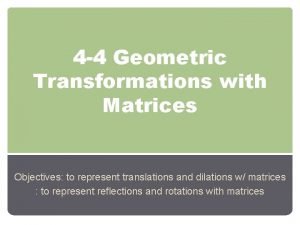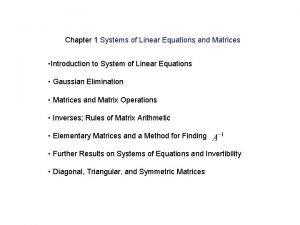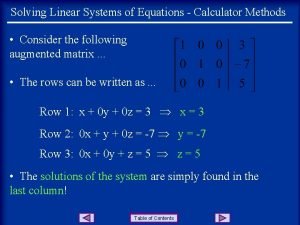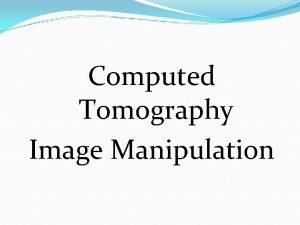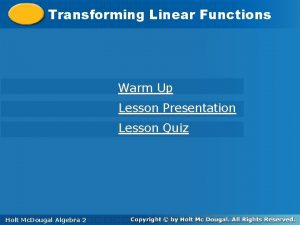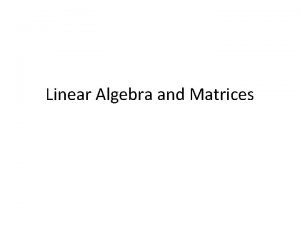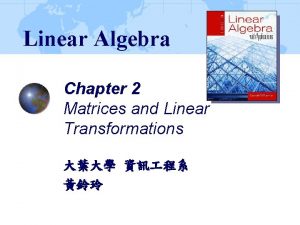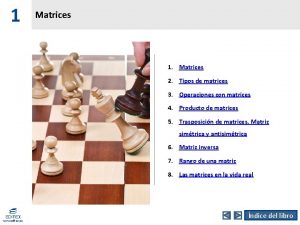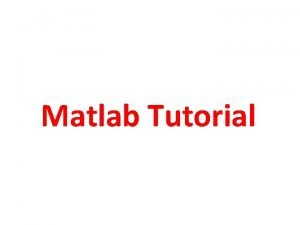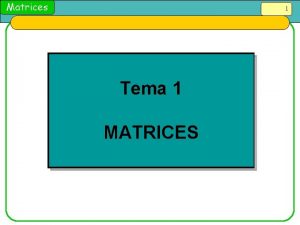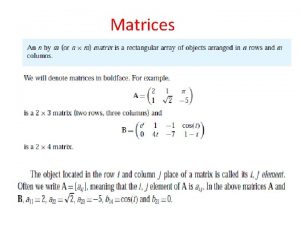IMAGE MANIPULATION VIA MATRICES Stephanie Orgill Linear Transformations












- Slides: 12

IMAGE MANIPULATION VIA MATRICES Stephanie Orgill

Linear Transformations ■ Ax = b is at the center of matrix transformations ■ Think of matrix A as an object that is acting on vector x by multiplication, which produces a new vector Ax. ■ The transformation from x� Ax follows a set of rules which preserve the operations of vector addition and scalar multiplication: – A(u + v) = Au + Av – A(cu) = c. Au ■ We can use these rules with transformation matrices to translate, shear, scale, rotate, and reflect images in 2 -D space

Translating ■ A vector X is translated by a vector V to X+V. Translation is with vector addition. ■ Say we wish to translate a triangle with vertices at (2, -1), (4, 3), and (-3, -2) 5 units left and 2 units up. To do this, we would take the triangle’s matrix A and add to it the transformation matrix that subtracts 5 from the x values and adds 2 to the y values: § Thus the triangle’s location matrix A, composed of vertices x 1, x 2, x 3 are translated by vectors v 1, v 2, v 3 to produce the translation matrix.

Shearing ■ A shear transformation is defined by T(x) = Ax. ■ Shearing a matrix causes each point, or each mij , to be displaced in a fixed direction by an amount proportional to its distance from a line parallel to that direction. ■ Shearing can occur along the vertical or horizontal axes by a scalar k: ■ As an example, let’s vertically shear the following matrix: § This has the effect of transforming the grey R into the lopsided red R seen to the right:

Scaling ■ There are two types of scaling: contraction and dilation ■ Contraction occurs when a matrix T is multiplied by a scalar k such that T(x) = kx when 0 ≤ k ≤ 1 ■ Dilation occurs when matrix T is multiplied by k such that T(x) = kx when k > 1 ■ Scaling means that the matrix and the image it represents either grows or shrinks. ■ Scaling is uniform when the x and y values are both scaled by the same k. ■ Take a simple 2 x 3 matrix and uniformly contract it by multiplying it by k = ½:

Scaling cont’d ■ Scaling does not have to be uniform. Scaling can occur along any axis by applying the correct scaling matrix:

Rotating ■ § This results in the grey R to the right being twisted about the origin by 30 degrees clockwise (represented by the red R):

Reflecting ■ Reflection is the act of flipping the image across a designated line, such that it is a mirror image of the original. ■ Common types of reflections with their respective matrices are listed below: § As an example, let’s flip an arbitrary (x, y) value across x = y and translate it 2 units in each direction to center it:

Transformations in 3 -D space ■ Transformations in 3 -D space follow the same rules as those in 2 -D space, but with slightly more complicated matrices. ■ 3 -D transformations require the use of 4 x 4 matrices, which may seem odd – what’s the fourth dimension? ■ 4 -D vectors define space along the x, y, and z axes as well as a fourth dimension w. This dimension is the projective space. ■ To better understand projective space, imagine it as a video projector that is showing a 2 -D image; w is the distance from the projector to the screen and it affects the image size/scale. § Since some 3 -D transformations (like translations) require the use of w, while others do not (like rotation). Remember that the rules of matrix multiplication dictate that a 4 x 4 matrix cannot be multiplied against a 3 x 3 matrix, so all 3 D transformations must use 4 x 4 matrices.

3 -D Transformation Matrices ■ The below matrices are examples of some 3 -D transformation matrices.

3 -D transformation Example: ■ Let’s say an object is located along the vector x = [4 3 2 1] and we want to: – translate it by -2 in the x direction, 3 in the y direction, and 1 in the z direction – rotate it by 45 degrees along the z axis and 30 degrees along the y axis – shear it in the x-direction by 45 degrees ■ The combined transformation matrix (T) is as follows, in order of translation, z rotation, y rotation, and shear:

Example cont’d & Conclusion: § Multiplying the location vector x by T will result in x being rotated, translated, and sheared as indicated in the previous slide. § In conclusion, matrix transformations are an essential part to many fields like computer science, robotics, and mechatronics. The process for transforming matrices is simple and follows a very clear and consistent set of rules.
 Linearly independent
Linearly independent Transformations using matrices
Transformations using matrices Homogeneous system of linear equations examples
Homogeneous system of linear equations examples System of equations calculator
System of equations calculator Decimoquinta estacion via crucis
Decimoquinta estacion via crucis Via negativa
Via negativa Imagenes del via lucis
Imagenes del via lucis Via piramidal primera y segunda neurona
Via piramidal primera y segunda neurona Via erudita e via popular
Via erudita e via popular General image manipulation program
General image manipulation program Window width ct
Window width ct Gimp es las iniciales de
Gimp es las iniciales de Lesson 6-4 transforming linear functions answer key
Lesson 6-4 transforming linear functions answer key

